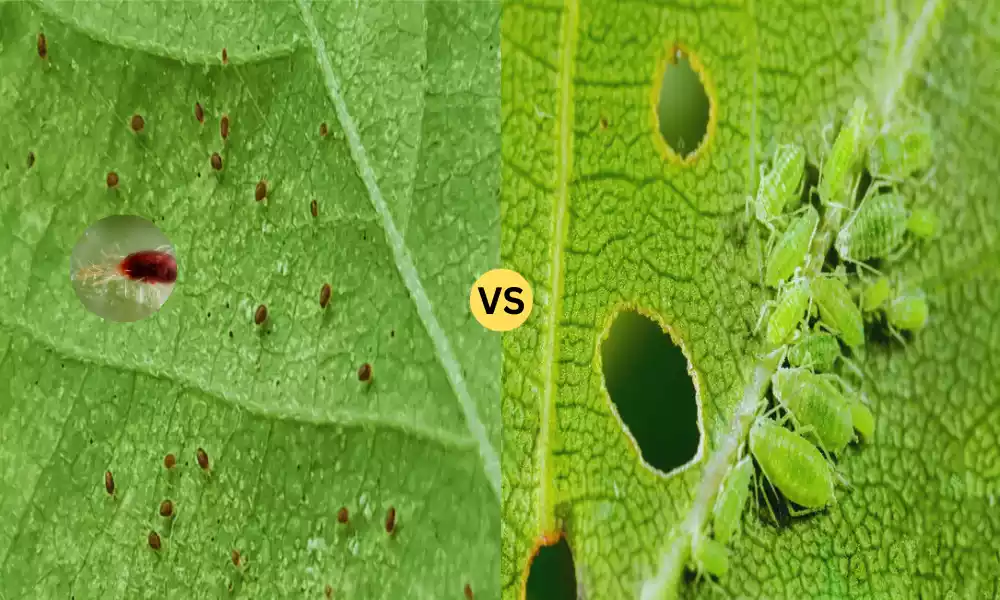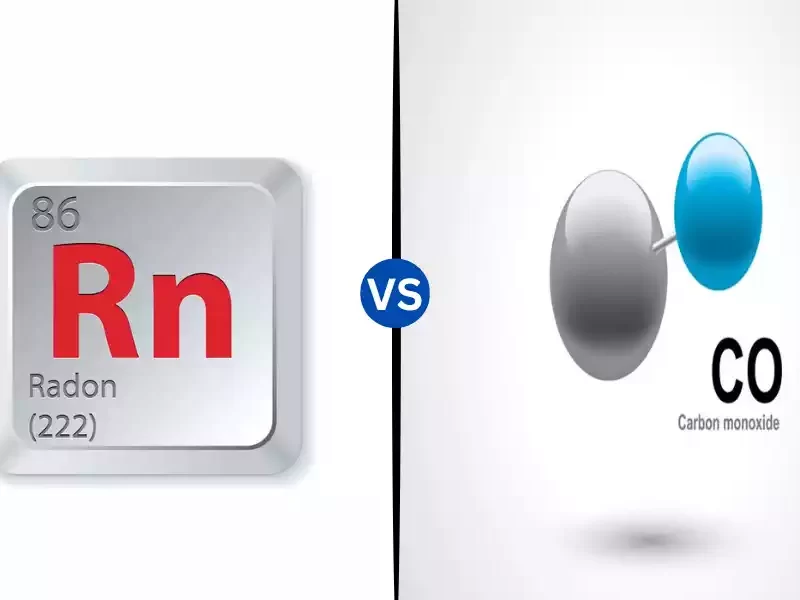Spider Mites and Aphids are two of the most common pests that gardeners and farmers encounter. Both are small, often going unnoticed until plant damage becomes apparent, and both can wreak havoc on a wide variety of plants. Spider mites, tiny arachnids often identified by the webbing they leave behind, suck out the cell contents from plants, leading to stippling and discoloration.
Aphids, on the other hand, are soft-bodied insects that feed on plant sap, secreting a sticky substance called honeydew and sometimes transmitting plant diseases in the process. Understanding the differences between these two pests is crucial for effective plant care and pest management.
Definition of Spider Mites
Spider mites are tiny arachnids belonging to the family Tetranychidae. They are not true insects but are more closely related to spiders, ticks, and scorpions. Often less than 1mm in size, they are generally found on the undersides of plant leaves. These mites feed by piercing individual plant cells and sucking out the contents, which can lead to various symptoms including stippling, yellowing, browning, or even the death of the plant if left unchecked. One of the most characteristic signs of a spider mite infestation is the fine, silky webbing they produce on the affected plants.
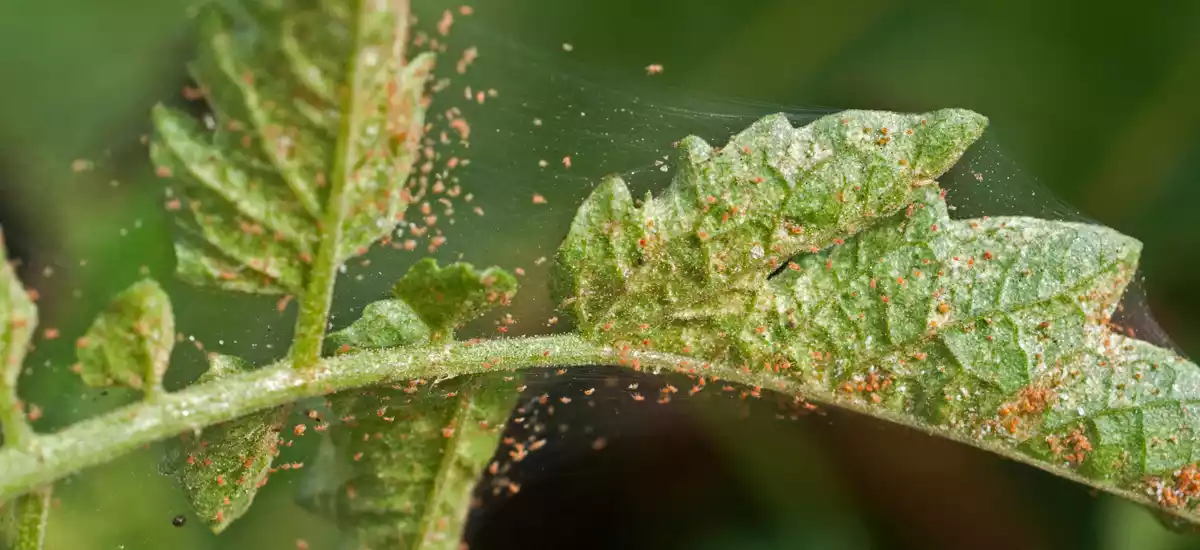
Definition of Aphids
Aphids are small, soft-bodied insects belonging to the superfamily Aphidoidea. They range in size from 1 to 10 millimeters and come in various colors, including green, black, brown, yellow, and sometimes even pink. Aphids primarily feed on the sap of plants, using their specialized mouthparts, known as stylets, to pierce plant stems and leaves and extract the nutrient-rich fluid.
As they feed, they excrete a sticky substance called honeydew, which can attract other pests like ants or lead to the growth of sooty mold. Aphids also have the potential to transmit plant viruses, making them a significant concern for gardeners and farmers. Many species of aphids possess a pair of tubular structures called cornicles on their hind end, which can be used for the secretion of defensive fluids.
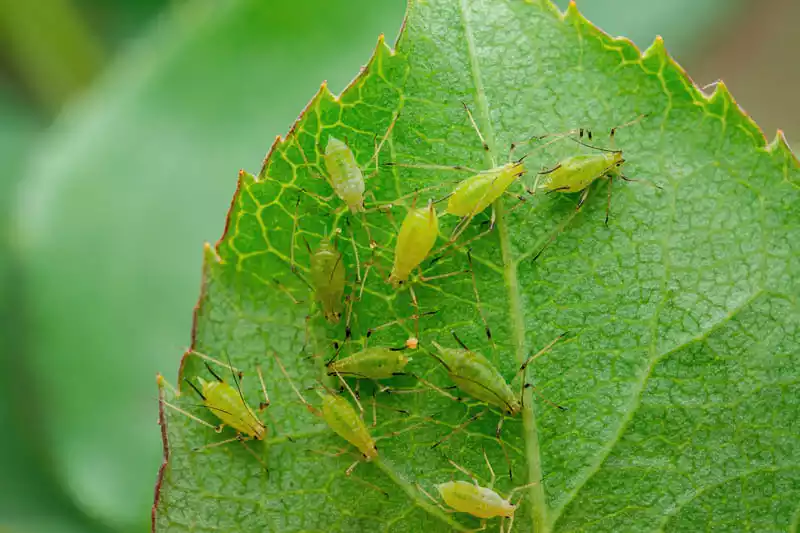
Comparison table of Spider Mites and Aphids
Below is a comparison table outlining the differences between Spider Mites and Aphids:
| Feature/Characteristic | Spider Mites | Aphids |
|---|---|---|
| Taxonomic Classification | Arachnids (Family Tetranychidae) | Insects (Superfamily Aphidoidea) |
| Size | Typically less than 1mm | 1 to 10 millimeters |
| Body Type | Small, oval | Soft-bodied |
| Related To | Spiders, ticks, scorpions | Other sap-sucking insects |
| Color Variations | Red, brown, yellow, green | Green, black, brown, yellow, pink |
| Feeding Method | Pierce plant cells and suck out contents | Pierce plant tissues and extract sap |
| Common Damage Signs | Stippling, webbing, discoloration | Honeydew secretion, sooty mold, curled leaves |
| Reproductive Method | Eggs and live birth, depending on species and conditions | Both viviparous (live birth) and oviparous (egg-laying) |
| Natural Predators | Predatory mites, ladybugs | Ladybugs, lacewing larvae, parasitic wasps |
| Transmission of Plant Diseases | Rarely | Often, can transmit various plant viruses |
| Defensive Structures/Features | None notable | Cornicles (tailpipe-like structures) |
This table provides a general overview, and there can be variations and exceptions within each group, especially given the wide diversity of species under both spider mites and aphids.
Habitats and Common Plants Affected
Both spider mites and aphids can be found in various habitats and on a multitude of plants. Here’s a detailed look at their habitats and the common plants they affect:
Spider Mites:
Habitats:
- Agricultural Fields: Especially in areas with crops like tomatoes, beans, corn, and strawberries.
- Greenhouses: The controlled, often dry environment can be particularly conducive for spider mite outbreaks.
- Orchards: Including those with apple, pear, and peach trees.
- Home Gardens: Both indoor and outdoor.
- Landscapes: Including trees, shrubs, and flowering plants.
Common Plants Affected:
- Vegetables: Beans, tomatoes, peppers, and cucumbers.
- Fruits: Apples, grapes, citrus fruits, and strawberries.
- Ornamental Plants: Roses, marigolds, and geraniums.
- Trees: Spruce, juniper, and arborvitae.
- Others: Cotton, hemp, and various houseplants.
Aphids:
Habitats:
- Agricultural Fields: Especially in areas with crops like grains, vegetables, and fruits.
- Greenhouses: Aphids can rapidly reproduce in these environments.
- Home Gardens: Both indoor and outdoor.
- Meadows and Grasslands: Due to the presence of their host plants.
- Trees: Many aphid species are tree specialists.
Common Plants Affected:
- Vegetables: Lettuce, peas, beans, potatoes, and tomatoes.
- Fruits: Apples, peaches, melons, and citrus fruits.
- Ornamental Plants: Roses, dahlias, chrysanthemums, and lilies.
- Trees and Shrubs: Oaks, pines, maples, and spruces. Certain aphid species are specific to particular tree types.
- Grains: Wheat, barley, and other cereals.
Both spider mites and aphids have an extensive host range, meaning they can infest and feed on a variety of plants. Recognizing the first signs of infestation on these common plants can help in early intervention and control.
Life Cycle and Reproduction
Both spider mites and aphids have distinctive life cycles and methods of reproduction. Here’s a detailed breakdown of their life cycles and reproductive strategies:
Spider Mites:
Life Cycle:
- Eggs: Laid on the undersides of leaves or within webbing; they’re spherical and transparent.
- Larva: The hexapod stage (six legs) that emerges from the eggs and begins feeding on the plant.
- First Nymphal Stage (Protonymph): After molting from the larval stage; has eight legs.
- Second Nymphal Stage (Deutonymph): After another molt; also has eight legs.
- Adult: The fully mature stage, where the mites are most reproductive.
Reproduction:
- Egg-laying: Adult females lay eggs after mating. Some species can reproduce without mating (parthenogenesis).
- Rapid Generation Time: In optimal conditions, a spider mite can progress from egg to adult in just one week.
- Population Explosion: Due to their rapid reproduction, populations can expand swiftly if not controlled.
Aphids:
Life Cycle:
- Nymphs: Aphids are born live (viviparously) in many generations as nymphs, which are smaller versions of adults.
- Adults: Nymphs molt multiple times (usually four) before reaching the adult stage.
Reproduction:
- Viviparous Reproduction: Many aphid species can give birth to live young without mating, producing genetically identical offspring (clones). This form of asexual reproduction is called parthenogenesis.
- Oviparous Reproduction: In some species and under specific conditions (often triggered by shorter days and cooler temperatures signaling the approach of winter), aphids will produce eggs instead of live young. This often coincides with the production of winged forms that can disperse to other plants or safe locations.
- Winged vs. Wingless: Depending on environmental conditions and population density, aphids can produce winged individuals which can migrate to other plants or areas, spreading infestations.
- Rapid Reproduction: Aphids can have many generations in a single year due to their quick reproduction cycle, especially in warm conditions.
Both spider mites and aphids have evolved reproductive strategies that allow them to quickly colonize and infest plants, leading to rapid population growth in favorable conditions. Their ability to reproduce rapidly makes them particularly challenging pests in agricultural and horticultural settings.
Damage to Plants
Spider mites and aphids, despite being tiny, can inflict significant damage to plants. Understanding the nature of the damage they cause is essential for timely detection and intervention.
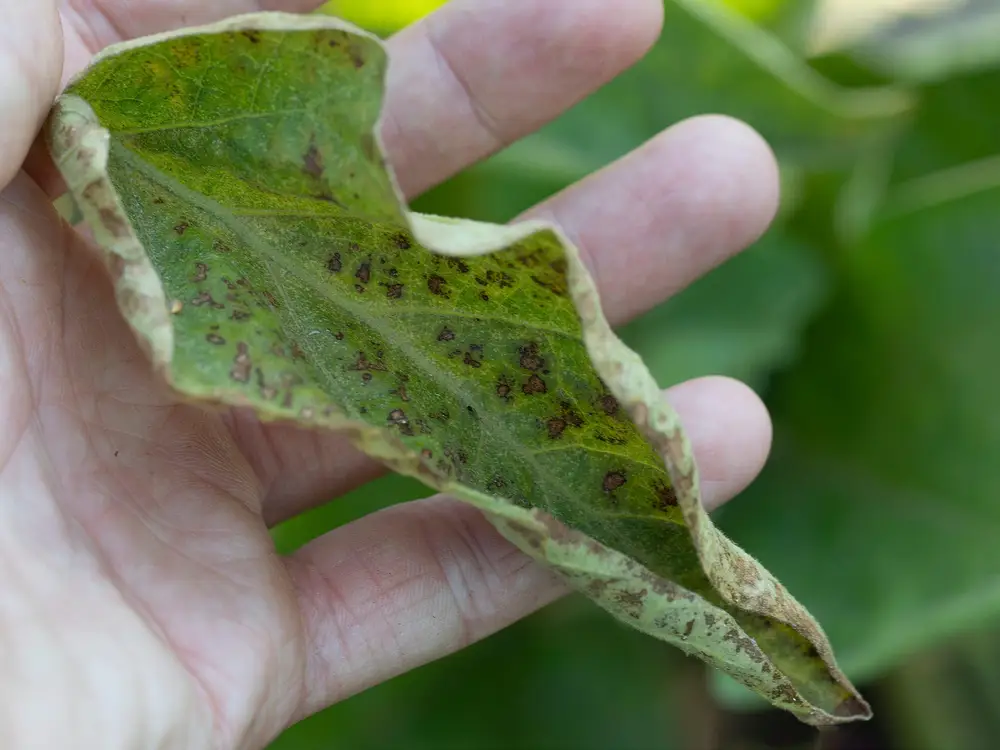
Spider Mites:
- Stippling: As spider mites feed, they pierce individual plant cells to suck out their contents. This action leads to tiny yellow or white dots on the leaves known as stippling.
- Leaf Discoloration: Heavily infested leaves can turn yellow, bronze, or even red.
- Leaf Drop: Severe infestations can cause leaves to dry up and fall off prematurely.
- Webbing: Spider mites produce fine, silky webs that can cover affected areas of plants. The webbing offers them protection from predators and environmental conditions.
- General Plant Weakness: Plants infested with spider mites might exhibit stunted growth, reduced vigor, and diminished yields in the case of crop plants.
- Visible Colonies: In severe cases, you can see colonies of mites, especially on the undersides of leaves.
Aphids:
- Honeydew Secretion: Aphids excrete a sugary substance called honeydew as they feed on plant sap. This sticky substance can attract other pests like ants and can also lead to the growth of sooty mold, a black, superficial fungus that can cover leaves and stems.
- Leaf Curling: Aphid feeding can cause leaves to curl, twist, or distort.
- Yellowing: Leaves can turn yellow due to the loss of sap and the action of aphid saliva.
- Stunted Growth: Aphid-infested plants may exhibit slowed growth or stunted development.
- Transmission of Diseases: Aphids can act as vectors for various plant viruses, transmitting them from one plant to another as they feed. This can lead to a range of disease symptoms, from mottled leaves to plant death.
- Presence of Ants: Ants are often attracted to the honeydew produced by aphids. They can “farm” aphids, protecting them from predators to ensure a continuous supply of honeydew.
- Galls: Some species of aphids induce the formation of galls (abnormal plant growths) where they live and feed.
Both spider mites and aphids suck out vital nutrients from plants. The physical damage, combined with the stress they induce on the plants, can lead to reduced vitality, growth, and yields. In severe cases, if left unchecked, both pests can lead to plant death. As such, regular monitoring and early intervention are crucial for effective management.
Natural Enemies
Both spider mites and aphids have natural enemies that can act as biological control agents, helping to keep their populations in check. These beneficial predators and parasites can be a crucial component of integrated pest management (IPM) strategies.
Spider Mites:
- Predatory Mites: Such as Phytoseiulus persimilis and Neoseiulus californicus. These are specialist predators of spider mites and can consume large numbers of them.
- Lady Beetles: Certain species, like Stethorus spp., are known to feed on spider mites.
- Predatory Thrips: Like the six-spotted thrips, which prey on spider mites.
- Minute Pirate Bugs: Orius spp. can also feed on spider mites.
- Predatory Insects: Like lacewing larvae, which can consume spider mites.
Aphids:
- Lady Beetles (Ladybugs): Both the adult and larval stages of many lady beetle species are voracious aphid eaters. Common species include Coccinella septempunctata and Hippodamia convergens.
- Lacewings: Green and brown lacewing larvae are avid aphid predators.
- Hoverflies (Syrphid Flies): Their larvae feed on aphids. Adult hoverflies are often seen hovering around plants and are good pollinators.
- Parasitic Wasps: Several species of tiny braconid and aphelinid wasps lay their eggs inside aphids. The developing wasp larvae consume the aphid from the inside, eventually leading to the aphid’s death. Aphids parasitized in this way turn into characteristic “mummies” which can often be seen on plants.
- Aphid Midges: Aphidoletes aphidimyza larvae are predators of aphids.
- Predatory Bugs: Such as the damsel bug (Nabis spp.) and big-eyed bug (Geocoris spp.), which consume aphids.
- Entomopathogenic Fungi: Some fungi, such as Beauveria bassiana and Lecanicillium spp., can infect and kill aphids.
To harness the potential of these natural enemies in controlling pest populations, it’s essential to:
- Avoid Broad-spectrum Insecticides: These chemicals can kill beneficial insects along with the pests.
- Provide Habitat: Flowering plants can provide nectar and pollen resources for adult predators and parasitoids, increasing their longevity and reproductive success.
- Purchase and Release: In some cases, it might be beneficial to purchase and release specific natural enemies into your garden or greenhouse, especially in the early stages of an infestation.
Understanding the role of these natural enemies in the ecosystem can lead to more sustainable and effective pest management practices.
Control and Management
Controlling and managing spider mites and aphids effectively often requires a multi-pronged approach. Integrated Pest Management (IPM) principles advocate combining various methods to achieve control while minimizing harm to beneficial organisms and the environment. Here are several methods used to manage these pests:
Spider Mites:
- Water Sprays: A strong jet of water can dislodge mites from plants. Regularly spraying the undersides of leaves can reduce mite populations.
- Predatory Mites: Introducing predatory mites like Phytoseiulus persimilis can be an effective biological control method, especially in greenhouses.
- Chemical Miticides: For heavy infestations, miticides specifically designed for spider mites might be required. Always follow label instructions.
- Insecticidal Soaps and Horticultural Oils: These can be effective against mites and are less toxic to beneficial insects.
- Environmental Controls: Maintaining higher humidity can deter spider mite proliferation, as they prefer drier conditions.
- Regular Monitoring: Regularly inspect plants, especially the undersides of leaves, for signs of mites or their webbing.
Aphids:
- Water Sprays: Just as with spider mites, a strong water jet can be effective in removing aphids from plants.
- Beneficial Insects: Introducing or encouraging beneficial insects like lady beetles, lacewings, and parasitic wasps can help manage aphid populations naturally.
- Insecticidal Soaps: These can suffocate and kill aphids without using harsh chemicals.
- Neem Oil: Acts as a repellent and can disrupt the life cycle of aphids.
- Chemical Insecticides: If infestations are severe, targeted insecticides might be necessary. However, frequent use can lead to resistance and harm beneficial insects.
- Ant Control: Since ants “farm” aphids for honeydew, controlling ant populations can help manage aphid numbers.
- Reflective Mulches: In vegetable gardens, using reflective mulches can deter aphids from colonizing plants.
- Resistant Plant Varieties: Choose plant varieties known for their resistance to aphids.
General Tips for Both Pests:
- Crop Rotation: Changing crops seasonally or annually can break the pest life cycle.
- Diversify Plantings: A diverse garden can attract a range of beneficial insects that can help keep pest populations in check.
- Regular Inspection: Check plants regularly to detect and manage infestations early.
- Remove Infested Plant Material: If a plant is heavily infested and beyond recovery, it’s often best to remove and dispose of it to prevent the pests from spreading.
- Avoid Over-fertilization: Excess nitrogen can lead to lush, soft growth, which is attractive to many pests, including aphids.
- Educate Yourself: Stay informed about the pests and their natural enemies. The more you know, the better equipped you’ll be to handle them.
Using a combination of these methods, tailored to the specific conditions of your garden or farm, can lead to effective and sustainable pest control.
Benefits in Nature
While spider mites and aphids are often regarded as pests, especially in agricultural and horticultural contexts, they do play roles in the ecosystem that can be seen as beneficial:
- Food Source: Both spider mites and aphids serve as a food source for various beneficial insects and other predators. Ladybugs, lacewings, predatory mites, and parasitic wasps are just a few of the organisms that feed on these pests. By providing sustenance for these predators, spider mites and aphids help sustain a biodiverse ecosystem.
- Pollination: Aphids, while feeding on plant sap, can sometimes facilitate the transfer of pollen between flowers, although they aren’t primary pollinators like bees or butterflies.
- Soil Enrichment: Dead aphids and mites, along with their waste products, contribute to organic matter in the soil. This organic matter can help improve soil structure and fertility over time.
- Natural Selection: The presence of these pests can drive plants to develop stronger defense mechanisms. Over evolutionary timescales, this can result in plants that are more resistant to pests and diseases.
- Ecosystem Indicators: A sudden increase in populations of spider mites or aphids might indicate an imbalance in the ecosystem. For instance, it could signal the absence of their natural predators due to environmental changes. This can help ecologists understand and rectify ecosystem imbalances.
- Research and Biological Control: Aphids, particularly, have been used in scientific research to understand plant-pathogen interactions. Additionally, the knowledge about their biology and behavior aids in the development of biological control methods for more harmful pests.
In natural ecosystems, it’s essential to recognize that every organism has a role to play. Even though they might be problematic in specific contexts (like gardens or farms), in nature, they fit into a larger web of interactions and relationships.
Conclusion
Spider Mites and Aphids, although small in size, pose significant challenges to gardeners and farmers due to their rapid reproduction rates and the damage they inflict on plants. Both pests draw vital nutrients from plants, causing symptoms like stippling, yellowing, and distorted growth, and in severe cases, can lead to plant death. Nature offers a range of biological control agents, from predatory mites to lady beetles, that can help in managing these pests.
Integrated Pest Management (IPM) practices, which combine various control methods, remain the most effective and environmentally-friendly approach to tackle these adversaries. By staying informed and vigilant, gardeners and farmers can mitigate the impact of spider mites and aphids and ensure the health and productivity of their plants.

